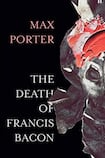
If writing about music is like dancing about architecture, what of painting? As Francis Bacon once said, “If you can talk about it, why paint it?” Indeed. In his third novel, Max Porter explores what happens when you contemplate canvases to the point of being contemplated by them.
Rather than talk about Bacon’s paintings, he lets them speak – or mutely howl – and what they express is not what they represent, but how they feel: the sensation of their own brute facticity. “I can still feel it, right through me, like a shock,” Bacon says here, remembering the time when he “bit down on shot” while dining out on pheasant stew: “Metal drill in my fillings right down through my urethra. Buzzing in my underbladder.”
Possibly moonlighting as the critic David Sylvester, the author plants a sneaky mission statement at the beginning of the fourth chapter, where he confesses his long-standing “unfashionable fixation” with the painter as well as his aim “to get art history out of the way”. (Pe once obtained an MA in this very subject at London’s Courtauld.)
Bacon is lying on his deathbed in a Madrid clinic, where he is attended to by a sister whom he addresses as Hermana or Mercedes (she calls him “piggy”) and regularly mistakes for figures from his past, such as his lover and muse Peter Lacy or photographer and Soho habitué John Deakin. Through a series of delirious dreams, his life is depicted in the visceral style of his work.
Tales of turpentine and turpitude, fisting and feasting commingle with children’s stories and striking imagery, while the artist ponders his legacy: “Oh naff off you skag,” he says apropos of one famous critic. Dying itself is leavened with dark levity: “I wonder if I might have no pain. If you’d be so kind.”
The opening section – one page long, text laid out like a poem, copious amounts of blank space – is devoted to a “[N]on-existent” sketch, from which we may infer that all the other works conjured up thereafter are authentic and still extant. Every subsequent chapter proceeds from a different oil on canvas – seven in all – of varying dimensions (the smallest being 14 x 12 inches).
Of little import at first blush, these measurements highlight the art’s materiality, enabling us to track down, with a fair degree of accuracy, most of the pieces Porter has purposely left untitled. They also allow us to ascertain that the sequence in which the paintings are summoned is strictly chronological down to the penultimate chapter, which is in keeping with the narrative’s biographical tenor.
Portraiture as vivisection
Porter spares us the tiresome ekphrases. Save for the aforementioned sketch, none of the artworks are described. The emphasis is placed firmly on the creative process and how the works “work”. The revelation of the models’ convulsive beauty, for instance, as soon as they twist and turn – a recurrent gesture that echoes Bacon’s retrospection. When the sister turns sitter she suddenly becomes a “handsome prospect”, her “crowded mouth” making the artist yearn to see her snarl: “that’s why she has to sit like that, as if sitting for me, lest those rows of teeth burp out”.
In one instance Bacon juxtaposes the boyish features of Don Carlos, seen on one painting, with Julius Caesar’s punctured body from another: “I folded the head over at the eyes and laid it on the injury.” This is portraiture as vivisection: “Yes, peeling a scab. Lifting the whole clotty lot of it and seeing the root. Verruca stippled. These are a few of my favourite things.”
The non-existent preparatory sketch, which Bacon cannot recall drafting, represents his own deathbed scene. It soon becomes apparent that with each new chapter and canvas, the sketch is being fleshed out. This impression is reinforced by the numerous repetitions: the sister’s incessant “Intenta descansar”, on which the book closes, produces a sort of litany: every chapter beginning with “Take a seat why don’t you” and containing questions pitting the painter against other figures (Edward the Martyr, Caesar, Mussolini, Caravaggio).
All the while, Bacon is painting his own departure until he absents himself through his work, resurfacing in canvases hanging in museums and galleries from whence he can spend an eternity mocking his critical foes. Self-portraiture as auto-autopsy.
The Death of Francis Bacon is a little masterpiece; a slim volume that packs a mean Peter Lacy-style punch. It is as though Porter had bit down on shot, taking the most adventurous passages from his two previous novels and letting rip – painting in words the “deeply ordered chaos” Bacon saw all about him.













